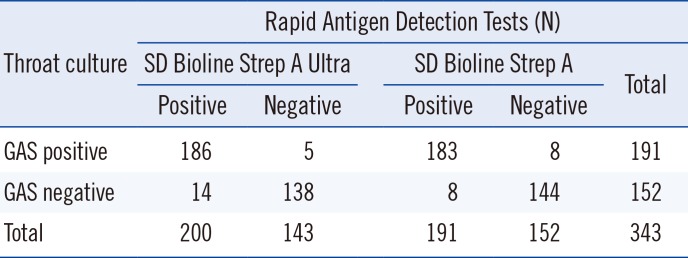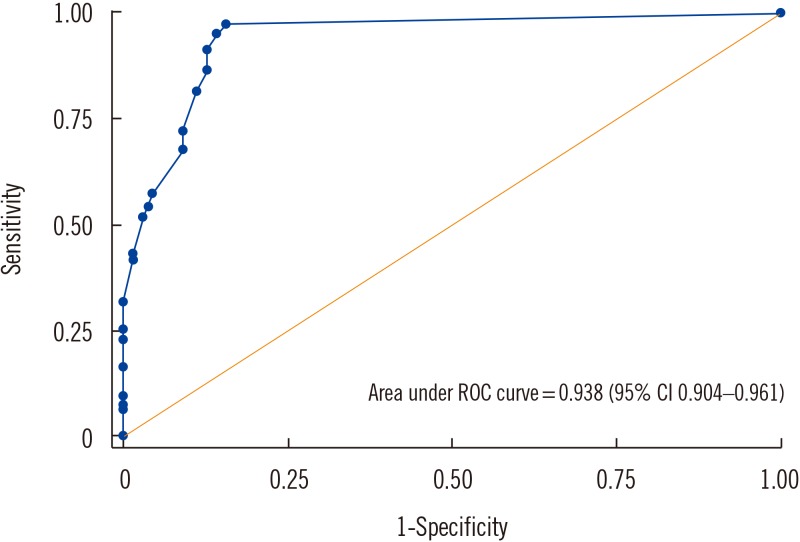1. Choby BA. Diagnosis and treatment of streptococcal pharyngitis. Am Fam Physician. 2009; 79:383–390. PMID:
19275067.
2. Edmonson MB, Farwell KR. Relationship between the clinical likelihood of group A streptococcal pharyngitis and the sensitivity of a rapid antigen-detection test in a pediatric practice. Pediatrics. 2005; 115:280–285. PMID:
15687433.
3. Kalra MG, Higgins KE, Perez ED. Common questions about streptococcal pharyngitis. Am Fam Phys. 2016; 94:24–31.
4. Wessels MR. Clinical practice. Streptococcal pharyngitis. N Engl J Med. 2011; 364:648–655. PMID:
21323542.
5. Gerber MA. Diagnosis and treatment of pharyngitis in children. Pediatr Clin North Am. 2005; 52:729–747. vi. PMID:
15925660.
6. Shulman ST, Bisno AL, Clegg HW, Gerber MA, Kaplan EL, Lee G, et al. Clinical practice guideline for the diagnosis and management of group A streptococcal pharyngitis: 2012 update by the Infectious Diseases Society of America. Clin Infect Dis. 2012; 55:1279–1282. PMID:
23091044.
7. Webb KH, Needham CA, Kurtz SR. Use of a high-sensitivity rapid strep test without culture confirmation of negative results: 2 years’ experience. J Fam Pract. 2000; 49:34–38. PMID:
10678338.
8. Cohen JF, Bertille N, Cohen R, Chalumeau M. Rapid antigen detection test for group A streptococcus in children with pharyngitis. Cochrane Database Syst Rev. 2016; 7:CD010502. PMID:
27374000.
9. Lean WL, Arnup S, Danchin M, Steer AC. Rapid diagnostic tests for group A streptococcal pharyngitis: a meta-analysis. Pediatrics. 2014; 134:771–781. PMID:
25201792.
10. Hall MC, Kieke B, Gonzales R, Belongia EA. Spectrum bias of a rapid antigen detection test for group A β-hemolytic streptococcal pharyngitis in a pediatric population. Pediatrics. 2004; 114:182–186. PMID:
15231926.
11. Kim S. The evaluation of SD Bioline Strep A rapid antigen test in acute pharyngitis in pediatric clinics. Korean J Lab Med. 2009; 29:320–323. PMID:
19726894.
12. Kurtz B, Kurtz M, Roe M, Todd J. Importance of inoculum size and sampling effect in rapid antigen detection for diagnosis of
Streptococcus pyogenes pharyngitis. J Clin Microbiol. 2000; 38:279–281. PMID:
10618101.
13. Gieseker KE, Mackenzie T, Roe MH, Todd JK. Comparison of two rapid
Streptococcus pyogenes diagnostic tests with a rigorous culture standard. Pediatr Infect Dis J. 2002; 21:922–927. PMID:
12394813.
14. Bisno AL. Acute pharyngitis. N Engl J Med. 2001; 344:205–211. PMID:
11172144.
15. Lieu TA, Fleisher GR, Schwartz JS. Clinical evaluation of a latex agglutination test for streptococcal pharyngitis: performance and impact on treatment rates. Pediatr Infect Dis J. 1988; 7:847–854. PMID:
3062561.
16. Dunne EM, Marshall JL, Baker CA, Manning J, Gonis G, Danchin MH, et al. Detection of group A streptococcal pharyngitis by quantitative PCR. BMC Infect Dis. 2013; 13:312. PMID:
23844865.
17. Hernes SS, Quarsten H, Hagen E, Lyngroth AL, Pripp AH, Bjorvatn B, et al. Swabbing for respiratory viral infections in older patients: a comparison of rayon and nylon flocked swabs. Eur J Clin Microbiol Infect Dis. 2011; 30:159–165. PMID:
20853014.
18. Dube FS, Kaba M, Whittaker E, Zar HJ, Nicol MP. Detection of
Streptococcus pneumoniae from different types of nasopharyngeal swabs in children. PLoS One. 2013; 8:e68097. PMID:
23840817.







 PDF
PDF ePub
ePub Citation
Citation Print
Print




 XML Download
XML Download